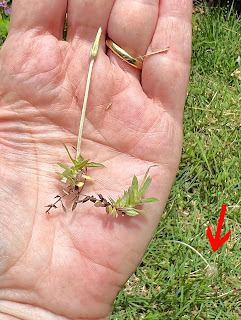A new weed from South America is showing up in southern
lawns and, unfortunately, I am the first person that I know of that has it! I
first read about this on a Facebook
post by the Alabama Extension Invasive Plant Page on May 12. On May 15, I
found it in my lawn. The name of it is skyseed (Chevreulia acuminata). It was first found in the US in 2012 in Alabama but
not identified until 2019.
 |
| Flower of Chevreulia acuminata |
This is a very short, small plant that spreads on thin, wiry stems. In last week’s blog, I talked about leaving turfgrass long enough to shade out weeds and keep the soil cool. Unfortunately, that approach doesn’t stop creeping, perennial plants like this from spreading. The thin, white flowering stems can produce flowers when only a few inches tall, allowing it to hide in the grass.
The flower on this plant appears on a white stem and
looks like a seedhead from the moment it opens. Once the flower goes to seed
(seemingly in just a few hours!), the seeds are easily detached, making this a
tricky one to remove. I know I didn’t get them all.
 |
| Creeping stems and emerging flower |
 |
| Flowers and seedheads look like dandelions |
I opted for manual removal, but I’m sure that some stems probably didn’t pull up completely. Over the course of this week, I discovered and pulled new ones every day from an area that is about 3x3 feet. How did it get here? This area of lawn is not near the street; rather it is a small semi-circle of grass near the front door.
Be on the lookout for this sneaky new weed. The puffy
flowers/seedheads will probably be the first you see of it. On Facebook,
another person reported finding it in Coweta County, a fair distance from my
lawn in Cherokee County. She had a good idea for gathering it up: she used her
portable vacuum cleaner to get the seedheads!
 |
| Typical plant size |
 |
| With penny for scale |
Note: the fluffy seedheads look similar to the annual trampweed (Facelis retusa) but that is a different weedy,
non-native plant.
Another very useful post, I would humbly suggest including the family name (even tho most would assume Asteraceae) just to help people recognize it more easily. I feel certain that if this plant is in your yard in Canton, it is in may lawns throughout the GA Piedmont. We will keep an eye out for this.
ReplyDeleteIt seems like I spend 90% of my gardening time hunting the invasive species and trying to get rid of them. They are so prolific! And we have to presume birds are actually eating some of them to spread the seeds so far and wide. Himalayan blackberry, Elaeagnus, privet, Japanese honeysuckle, and Nandina are just a few that the birds might have brought (or might have been planted by previous owners) and are SO hard to eradicate. Nandina berries are actually poisonous to birds, but in particular migrating Cedar Waxwings will eat them (and often die of cyanide poisoning). Thanks for your warning of yet another plant to watch for!
ReplyDelete